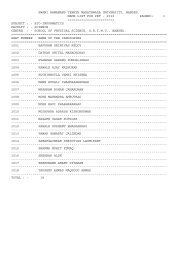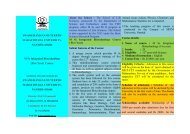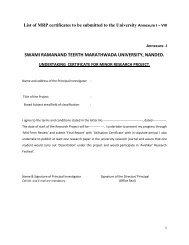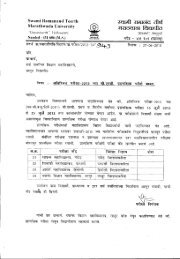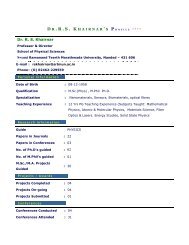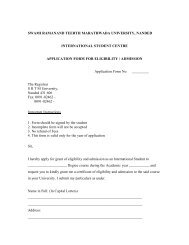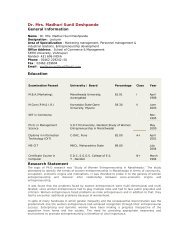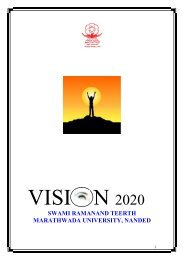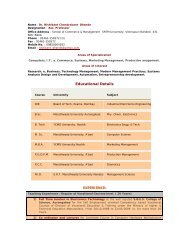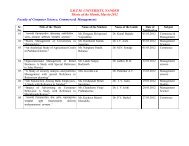Syllabus - The Swami Ramanand Teerth Marathwada University
Syllabus - The Swami Ramanand Teerth Marathwada University
Syllabus - The Swami Ramanand Teerth Marathwada University
You also want an ePaper? Increase the reach of your titles
YUMPU automatically turns print PDFs into web optimized ePapers that Google loves.
<strong>Swami</strong> <strong>Ramanand</strong> <strong>Teerth</strong> <strong>Marathwada</strong> <strong>University</strong>, Nanded<br />
School of Technology<br />
M.Pharm (Pharmaceutics) <strong>Syllabus</strong><br />
Credit-grade based performance and assessment system (CGPA))<br />
Features of the Credit System<br />
With effect from September 2008
FEATURES OF THE CREDIT SYSTEM<br />
• Master’s degree would be of 75 credits each.<br />
• One credit course of theory will be of one clock hour per week running for 12<br />
weeks.<br />
• Two credit course of theory will be of two clock hours per week running for<br />
12 weeks.<br />
• Four-credit course of theory will be of four clock hours per week running for<br />
12 weeks.<br />
• One credit course of practicals will consist of 4 hours of laboratory exercise<br />
for 6 weeks.<br />
• Two credit course of practicals will consist of 4 hours of laboratory exercise<br />
for 12 weeks.<br />
• Four credit course of practical will consist of 8 hours of laboratory exercise for<br />
12 weeks.
ACADEMIC CALENDAR AND TERMS<br />
<strong>The</strong> terms and academic activities of the School of Technology under CGPA shall be<br />
as per the dates given below, only the years shall be changed i.e. the dates shall<br />
remain same as given below irrespective of the year.<br />
Beginning of First Term (Semester I and III) : September 05<br />
Teaching begins (Semester III) : September 15<br />
Teaching begins (Semester I) : September 22<br />
Teaching ends (Semester III) : February 05<br />
Teaching ends (Semester I) : February 10<br />
Semester End Examination : February 20<br />
End of First Term : March 09<br />
Vacation : October 07 to Nov. 06<br />
Beginning of Second Term (Semester II and IV) : March 10<br />
Teaching begins : March 16<br />
Teaching ends : August 05<br />
Semester End Examination : August 17<br />
End of Second Term : August 31<br />
Vacation : May 09 to June 05
<strong>Swami</strong> <strong>Ramanand</strong> <strong>Teerth</strong> <strong>Marathwada</strong> <strong>University</strong>, Vishnupuri, Nanded<br />
M.Pharm. <strong>Syllabus</strong> Credit System<br />
Effective from September 2008<br />
M. Pharm. Pharmaceutics<br />
Semester-I<br />
Subject code Subject Marks Credits<br />
MPY -101 Research Methodology & Biostatistics 100 04<br />
MPY -102 Advance Analytical Techniques 100 04<br />
MPY -103 Quality Assurance of Pharmaceutical Products 100 04<br />
MPY -104 Drug Regulatory Affairs 100 04<br />
MPY -105 Laboratory course -1 100 04<br />
MPY -106 Laboratory course -2 100 04<br />
MPY -107 Seminar 025 01<br />
Total 625 25<br />
Semester-II<br />
Subject code Subject Marks Credits<br />
MPY -211 Novel Drug Delivery Systems 100 04<br />
MPY -212 Biopharmaceutics & Pharmacokinetics 100 04<br />
MPY -213 Industrial Pharmacy 100 04<br />
MPY -214 Advanced Pharmaceutics & Cosmaticology 100 04<br />
MPY -215 Laboratory Course -3 100 04<br />
MPY -216 Laboratory Course -4 100 04<br />
MPY -217 Seminar 025 01<br />
Total 625 25<br />
Semester-III<br />
Subject code Subject Marks Credits<br />
MPY -311 Seminar on Research envisaged for dissertation 100 04<br />
MPY -312 Seminar on recent trends in 150 06<br />
pharmaceutical sciences<br />
Total 250 10<br />
Semester-IV<br />
Subject code Subject Marks Credits<br />
MPY-411 Dissertation 200 08<br />
MPY-412 Seminar (on dissertation) 075 03<br />
MPY-413 Viva-voce 100 04<br />
Total 375 15
<strong>Swami</strong> <strong>Ramanand</strong> <strong>Teerth</strong> <strong>Marathwada</strong> <strong>University</strong>, Nanded<br />
School of Technology<br />
M.Pharm. <strong>Syllabus</strong> (Credit System)<br />
Effective from September 2008<br />
M. Pharm. (Semester – I)<br />
Pharmaceutics<br />
Subject code : MPY-101<br />
Subject : RESEARCH METHODOLOGY & BIOSTATISTICS<br />
THEORY 60 Hours (4 hrs. /week)<br />
I. Research:<br />
1. Meaning of research, purpose of research and types of research (clinical<br />
experimental, basic, applied and patent and oriented research) objects of<br />
research (4 hrs).<br />
2. Literature survey:<br />
� Using library, book and journals, MEDLINE- internet getting patents and<br />
reprints of articles as sources for literature survey. (2 hrs)<br />
3. Selecting a problem and preparing a research proposal for different types of<br />
research<br />
sources of procurements of grants. (2 hr)<br />
4. Documentation: (4 hrs)<br />
� Importance of documentation in case of research record and GMP/GLC<br />
� Techniques of documentation in case of research record and GMP and<br />
GLC<br />
� Uses of computer packages in clinical trials<br />
� Documentation in clinical trails<br />
5. Research report/paper writing/thesis writing / poster presentation: (10 hrs)<br />
� Different parts of research report or paper<br />
� Title-title of project with authors name<br />
� Abstract-statement of the problem, background list in brief, purpose and<br />
scope<br />
� Key words<br />
� Methodology-subject, apparatus/instrumentation and procedure<br />
� Results-tables, graphs, figures and statistical presentation<br />
� Discussion-support or non-support to hypothesis. Practical and theoretical<br />
implications<br />
� Acknowledgements<br />
� References<br />
� Errata<br />
� Importance of spell check<br />
� Use of foot notes
II. Methods and tools used in research: (5 hrs)<br />
� Research design (futures of good design, types of research designs, basic<br />
principles of experimental design).<br />
� Qualitative studies, quantitative studies.<br />
� Simple data organization, descriptive data organization.<br />
� Limitations and sources of errors.<br />
� Enquiries in forms of questionnaire, opinionnaire and interviews<br />
III. Presentation: (5 hrs)<br />
� Importance, types, different skills<br />
� Content of presentation format of model, introduction and endings.<br />
� Posture, gesture, eye contact, facial expression, stage fright.<br />
� Volume, pitch, speed, pauses and languages<br />
� Visual aids and seating arrangements<br />
� Question and answer session<br />
IV. Cost Analysis of Projects and Clinical Trials (3 hrs)<br />
V. Biostatistics ( 10 hrs )<br />
� Statistical analysis of data including variance, standard deviation, students<br />
‘t’ test and ANOVA, co relation of data and its interpretation, computer<br />
data analysis, bio statistics for clinical trials.<br />
� Scientific method in medicine<br />
� Scientific equations of therapy<br />
VI. Home Assignment<br />
1. Industrial institute interaction<br />
2. Industrial projects their feasibility reports.<br />
3. Funds in research<br />
4. GATT trips<br />
References:<br />
(1) Research in education – John W. Best Jems V. Kahn<br />
(2) Research methodology – C. R. Kothari<br />
(3) Methodology and techniques of social research – Willkinson and Bhandarkar<br />
(4) Presentation skills – Michel Halton – Indian society for institute education<br />
(5) Practical introduction to copyrights – Gavin Mofariane<br />
(6) <strong>The</strong>sis projects in sciences and engineering – Richard M. Devis<br />
(7) Scientist in legal system – Ann Labor Science<br />
(8) <strong>The</strong>sis and assessment writing – Janolthon Anderson<br />
(9) Writing a technical paper – Donald Manzel<br />
(10) Effective business report writing – Lel and Brown<br />
(11) Protection of industrial property rights – Purshottam Das and Gokul Das<br />
(12) Spelling for millions – Edna Furmess<br />
(13) Preparation for publications – King Edwards hospital foundation for London<br />
(14) Information technology – <strong>The</strong> hindu speeks<br />
(15) Documentation – genesis and development – 3792.<br />
(16) Ayurveda and modern medicine – R. D. Lele
(17) How to write and publish a scientific paper – Robert A. Day Cambridge<br />
<strong>University</strong> Press 4 th edition 1994<br />
(18) Lecture notes on patent TIFAC: DOC: 022, TIFAC July 2002.<br />
(19) Introduction to Statistical Methods- C. B. Gupta<br />
(20) A first course in Mathematical Statistics- C. E. Weatherborn<br />
(21) Introduction to Biostatistics-Mahajan<br />
Subject code : MPY -102<br />
Subject : ADVANCED ANALYTICAL TECHNIQUES<br />
THEORY 60 Hours (4 hrs. /week)<br />
1 Spectroscopic methods: <strong>The</strong>ory, Instrumentation, chemical applications and<br />
structural elucidation by UV, IR, FTIR, NMR, C 13 NMR, Mass Spectrometry,<br />
ESR and Emission spectroscopy. (25 hrs)<br />
2. Separation Techniques: Fundamental principles, theory, instrumentation and<br />
applications of Gas-liquid chromatography, HPLC, Gel chromatography, GC-<br />
MS, HPTLC, and Ion Pair Chromatography. (15 hrs)<br />
3. <strong>The</strong>rmal Analysis: <strong>The</strong>ory, Instrumentation and applications of<br />
<strong>The</strong>rmogravimetric Analysis (TGA) and Differential <strong>The</strong>rmal Analysis<br />
(DTA). (5 hrs)<br />
4. Home Assignment<br />
Immunochemical Techniques: Immunoelectrophoresis,<br />
Immunoprecipitation, ELISA, Radioimmunoassay.<br />
References:<br />
(1) <strong>The</strong>ory and applications of ultraviolet spectroscopy – M. Orchin and H. H.<br />
Jaffe, John Wiley and Sons, N. Y.<br />
(2) Spectrometric identification of organic compounds – Silverstein, Basseler,<br />
Morril, John Wiley and Sons, N. Y.<br />
(3) Instrumental Methods of Analysis– Willard, Merritt, Dean, CBS-Publishers<br />
and Distributors, Delhi<br />
(4) Applications of Absorption Spectroscopy of Organic Compounds – J. R. Dyer,<br />
Prentice Hall, London<br />
(5) Chemical Applications of Infra-red spectroscopy – C. N. R. Rao., Academic<br />
Press, N. Y.<br />
(6) Applications of NMR spectroscopy in organic chemistry – L. M. Jackmann<br />
and B. D. Sternhell, Pergamon Press, London<br />
(7) Interpretation of Mass Spectra. – F. W. McLafferry<br />
(8) Introduction to High Performance Liquid Chromatography – R. J. Hamilton,<br />
Chapman and Hall, London<br />
(9) Pharmaceutical Analysis Modern Methods-Part A and Part B – J. W. Munson,<br />
Marcel and Dekker<br />
(10) Indian Pharmacopoeia-2007<br />
(11) Martindale: <strong>The</strong> complete Drug Reference – 2007<br />
(12) Impurities Evaluation of Pharmaceuticals- Satinder Ahuja<br />
(13) Modern Instrumental Analysis, Vol 47(Comprehensive Analytical Chemistry)<br />
- Satinder Ahuja , Neil Jespessen<br />
(14) Practical HPLC Method Development, 2 nd Edition- Lloyd R. Snyder, Joseph J.<br />
Kirkland, Joseph L. Glajch
Subject code: MPY -103<br />
Subject : QUALITY ASSURANCE OF PHARMACEUTICAL PRODUCTS<br />
THEORY 60 Hours (4 hrs. /week)<br />
1. Good manufacturing practices: GMP in manufacturing processing and quality<br />
control of drugs, control of facility, personal, production and process controls,<br />
packaging and labeling controls, documents, WHO GMP guidelines. GMP for<br />
ayurvedic products, Good clinical practice (GCP), Good laboratory practice<br />
(GLP), Good Pharmacy practice (GPP) (10 hrs)<br />
2. Validation: Pharmaceutical process validation, equipment validation and sterile<br />
products validation. (10 hrs)<br />
3. Quality control of pharmaceutical dosage forms: Solid and semi-solid<br />
dosage forms, disperse systems and parenteral dosage forms. (8 hrs)<br />
4. ICH Stability Guidelines (3 hrs)<br />
5. Schedule M and Schedule Y (14 hrs)<br />
6. Home Assignment<br />
1. Preparation of Validation Protocol for different dosage form and<br />
preparation of SOP for Laboratory Instruments / Equipments.<br />
2. <strong>The</strong> Indian Patent Act 1970 and Amendments.<br />
References:<br />
(1) Automation and Validation of information in Pharmaceutical Processing – J. F.<br />
Despautz,Marcel and Dekker<br />
(2) Validation of aseptic pharmaceutical processing – F. J. Carleton and J. P.<br />
Agalloco, Marcel and Dekker<br />
(3) Pharmaceutical process validation – J. R. Berry and R. A. Nash, Marcel and<br />
Dekker<br />
(4) Good Manufacturing Practices for pharmaceuticals – S. H. Will and J. R.<br />
Stoker, Marcel and Dekker<br />
(5) Design of Experiments for process improvement and quality Assurance – R. F.<br />
Brewer<br />
(6) Law and drug –S. N. Katju, Law of publication (I) Pvt Ltd<br />
(7) Encyclopedia of pharmaceutical technology, Marcel and Dekker<br />
(8) Achieving sterility in medical and pharmaceutical products – N.A.Halls, Marcel<br />
and Dekker
Subject code : MPY -104<br />
Subject : DRUG REGULATORY AFFAIRS<br />
THEORY 60 Hours (4 hrs. /week)<br />
1. Aims, objects and salient features of following legislations affecting<br />
pharmaceutical industry. (5 hrs)<br />
� Industrial Development and Regulation Act 1951.<br />
� Consumer Protection Act.<br />
2. Australian TGA guidelines (2 hrs)<br />
3. US-FDA, CDER guidelines (5 hrs)<br />
4. New Drug Application (4 hrs)<br />
5. Pollution and Environmental Control Act (3 hrs)<br />
6. Drug Master File (3 hrs)<br />
7. Intellectual Property Rights: (10 hrs)<br />
� Protection of patients and trademarks and design and copy rights and<br />
patent system in India.<br />
� Present status of IPR future changes expected in Indian patents.<br />
� What may be patented<br />
� Who may apply for patent<br />
� Preparation of patent proposal<br />
� Registration of patent in India and foreign countries and vice versa<br />
� ICH guidelines for clinical trials, therapeutic drugs monitoring drugs and<br />
bioequivalence.<br />
� Exclusive marketing rights<br />
� Black box<br />
� IPR and IDMA views on patents<br />
� Human health and patent laws latent lethality<br />
� Indian patent act and copyright (Indian act)<br />
8. Drug and Cosmetics Act 1940 (8 hrs)<br />
9. Prevention of Food Adulteration Act 1954 (5 hrs)<br />
10. Home Assignment<br />
1. Preparation of DMF, Site Master File, Master Formula Record.<br />
2. Procedure for filing of Patent.<br />
Reference:<br />
(1) Guidelines of various countries like MCA, TGA, ICH.<br />
(2) Drug and cosmetic act 1940 and rules their under<br />
(3) IPR Lecture notes<br />
(4) GLP regulation by Alen Hirsch Vol 38 Marcel Decker series<br />
(5) GMP for pharmaceuticals forth edition by S. Willing, J. Stocker Marcel Decker<br />
series 1997.
(6) I.P., B.P., U.S.P. International Pharmacopoeia<br />
(7) Pharmacokinetics, Regulatory, Industrial, academic prospective by P. G. Willing<br />
and F.T.S. Tse.<br />
Subject code : MPY-105<br />
Subject : Laboratory course -1<br />
Practical 8 hrs. /week (Minimum 12 practicals should be conducted)<br />
1. Combination Drug Analysis (any two)<br />
Vitamins, Sulphas, Analysis of Antipyretics and Analgesics, Steroidal antiinflammatory<br />
drugs, Antihistamins.<br />
2. Illustrations of theoretical principles using assay of drugs form in various<br />
pharmacopoeias (any five).<br />
This should cover titrimetric, gravimetric, spectro-photometric (including<br />
flame photometric) methods. HPLC etc. <strong>The</strong> titrimetric methods should<br />
include agrentometric, conductometric, potentiometric end point<br />
determination. <strong>The</strong> students should be exposed to handling of as many<br />
instruments as possible by themselves or under the guidance of a teacher.<br />
3. Interpretation of UV, IR, NMR, C 13 NMR spectra and Mass Spectroscopy of<br />
some chemicals and drugs. (minimum three combined spectra).<br />
4. Preparation of research proposal for a specific problem and assessment<br />
(any two).<br />
References:<br />
(1) Pharmaceutical Analysis – Modern methods – Part A and Part B – J. W.<br />
Munson, Marcel – Dekker<br />
(2) Quantitative Analysis of Drugs in Pharmaceutical formulations – P. D. Sethi,<br />
VBS Publishers, Delhi<br />
(3) Pharmacopoeia of India.<br />
(4) Practical Pharmaceutical Chemistry, Part I and Part II – A. H. Beckett, J. B.<br />
Stenlake, CBS Publishers, Delhi<br />
(5) Colorimetric Methods of Analysis – F. D. Snell and C. T. Snell, Van Nostrand<br />
Reinhold Company, N. Y.<br />
(6) Chemical Applications of Infrared spectroscopy – C. N. R. Rao, Academic<br />
Press N. Y.<br />
(7) Applications of Absorption Spectroscopy of Organic Compound – J. R. Dyer,<br />
Prentice Hall Englewood
Subject code : MPY-106<br />
Subject : Laboratory course -2<br />
Practical 8 hrs. /week (Minimum 12 practicals should be conducted)<br />
Experiments based on following concepts:<br />
1. Validation of equipments: Autoclave, hot air oven, membrane filter<br />
(Minimum two practical).<br />
2. Validation of an analytical method: Calibration of instruments as per official<br />
procedure (UV,FTIR, Conductivity meter, flourimeter, Digital pH meter,<br />
Digital balance, Potentiometer, HPLC, Gas chromatography)<br />
(Minimum two practical).<br />
3. Quality control of pharmaceutical dosage forms: Tablets, Capsules, Liquid oral,<br />
Parenteral, External preparation (minimum eight practical).<br />
References:<br />
(1) Pharmaceutical Analysis – Modern methods – Part A and Part B – J. W.<br />
Munson, Marcel – Dekker<br />
(2) Quantitative Analysis of Drugs in Pharmaceutical formulations – P. D. Sethi,<br />
VBS Publishers, Delhi<br />
(3) Pharmacopoeia of India.<br />
(4) Practical Pharmaceutical Chemistry, Part I and Part II – A. H. Beckett, J. B.<br />
Stenlake, CBS Publishers, Delhi<br />
(5) Colorimetric Methods of Analysis – F. D. Snell and C. T. Snell, Van Nostrand<br />
Reinhold Company, N. Y.<br />
(6) Chemical Applications of Infrared spectroscopy – C. N. R. Rao, Academic<br />
Press N. Y.<br />
(7) Applications of Absorption Spectroscopy of Organic Compound – J. R. Dyer,<br />
Prentice Hall Englewood
<strong>Swami</strong> <strong>Ramanand</strong> <strong>Teerth</strong> <strong>Marathwada</strong> <strong>University</strong>, Nanded<br />
School of Technology<br />
M.Pharm. <strong>Syllabus</strong> (Credit System)<br />
Effective from September 2008<br />
M. Pharm. (Semester – II)<br />
Pharmaceutics<br />
Subject code : MPY-211<br />
Subject : NOVEL DRUG DELIVERY SYSTEM<br />
THEORY 60 Hours (4 hrs. /week)<br />
1. SUSTAINED AND CONTROLLED RELEASE DRUG DELIVERY<br />
SYSTEMS 14 hours<br />
Introduction; Rationale of SRDDS; Advantages and Disadvantages of SRDDS;<br />
Factors influencing the design and performances of SRDDS: A) Physicochemical<br />
properties of a drug influencing design and performance; B) Biological factors<br />
influencing design and performance of SRDDS. Different Micro- encapsulation<br />
processes.<br />
Introduction, Design and Development of oral controlled release drug administration:<br />
Dissolution controlled, Diffusion controlled (Reservoir devices, Matrix devices),<br />
Membrane permeation controlled, Osmotic pressure controlled, Gel diffusion<br />
controlled, pH controlled, Ion - exchange controlled delivery systems.<br />
2. POLYMERS SCIENCE 5 Hours.<br />
Introduction, Polymer-classification, Applications of Polymers in formulation of<br />
controlled drug delivery systems, Biodegradable and Nonbiodegradable polymers,<br />
Properties of following commonly used polymers- Starch, Gelatin, Chitosan,<br />
Albumin, Cellulose derivatives and Poloxamers.<br />
3. TRANSDERMAL DRUG DELIVERY SYSTEMS 6 Hours<br />
Permeation through skin, Factors affecting permeation, Basic components of TDDS,<br />
Formulation approaches used in development of TDDS and their evaluation,<br />
Permeation enhancers.
5. MUCOADHESIVE DRUG DELIVERY SYSTEMS 7 Hours<br />
Introduction, 1) Buccal drug delivery system: Concepts, Advantages and<br />
Disadvantages, Structure of oral mucosa, Trans-mucosal permeability, Permeability<br />
enhancers, in vitro and in vivo methods for Buccal absorption; 2) Nasal Drug Delivery<br />
Systems: Introduction, Physiology of nose, Fundamentals of nasal absorption,<br />
Distribution of drug in the nasal cavity, Enhancement in absorption, in vitro and in<br />
vivo methods for determination of nasal absorption.<br />
6. OCCULAR DRUG DELIVERY SYSTEMS 3 Hours<br />
Formulation and evaluation of occular controlled drug delivery systems, ophthalmic<br />
inserts and in situ gels.<br />
7. TARGETED DRUG DELIVERY SYSTEMS 10 Hours<br />
Concepts, Advantages and Disadvantages, Targeting of drugs through nanoparticles,<br />
liposomes, resealed erythrocytes, microspheres, magnetic microspheres, monoclonal<br />
antibodies, pulsatile drug delivery. Study on colon targeting. Biosome.<br />
HOME ASSIGNMENT:<br />
Protein & Peptide Drug Delivery System<br />
Physical aspects, biochemistry of protein drug (structure, properties & stability),<br />
barrier to transport & pharmacokinetics, different routes of delivery.<br />
Intrauterine Drug Delivery Systems<br />
Development of intrauterine devices (IUDs), copper IUDs, hormone-releasing<br />
IUDs.<br />
REFERENCE BOOKS:<br />
1. Encyclopedia of controlled delivery; By Edith Mathiowitz, Published by Wiley<br />
Interscience Publication, John Wiley and sons, Inc, New York / Chichester /<br />
Weinheim.<br />
2. Controlled and Novel Drug Delivery; By N.K.Jain, CBS Publishers and<br />
Distributors, New Delhi, First edition, 1997 (reprint in 2001).<br />
3. Controlled Drug Delivery - Concepts and Advances; By S.P.Vyas and R.K.Khar,<br />
Vallabh Prakashan, New Delhi, First edition, 2002.<br />
4. Remington’s Pharmaceutical Sciences.
5. Novel drug delivery system; By Y.M.Chien, Marcel Dekker, Inc.<br />
6. Controlled Drug Delivery - Fundamentals and Applications, 2nd edition; By<br />
Joseph R.Robinson and Vincent H.L.Lee.<br />
7. Pharmaceutical Dosage forms, disperse system: Volume 1, By Herbert<br />
A.Libermann et.al, Marcel Dekker, Inc.<br />
8. Pharmaceutical Dosage forms: Tablets Volume II, Herbert A.Libermann et.al,<br />
Marcer Dekker, Inc.<br />
9. Bentley’s Textbook of Pharmaceutics; By E.A.Rawline, ELBS Publications.<br />
10. Microencapsulation and Related Drug Process; By Patric B.Deasy.<br />
Subject code: MPY-212<br />
Subject : BIOPHARMACEUTICS AND PHARMACOKINETICS<br />
THEORY 60 Hours (4 hrs. /week)<br />
1. ABSORPTION OF DRUGS 7 Hours<br />
Definition, Structure of cell membrane and composition, Gastrointestinal absorption –<br />
Mechanism, Factors affecting drug absorption: Biological, Physiological, Physico-<br />
Chemical and Pharmaceutical dosage form factors; Methods of determining<br />
absorption: In Vitro and In Vivo methods.<br />
2. DISTRIBUTION OF DRUGS 7 Hours<br />
Definition, Distribution in blood and other fluids: cellular distribution, drug<br />
penetration to CNS, placental transfer of drugs and blood flow, Factors affecting drug<br />
distribution, Volume of distribution,<br />
3. PROTEIN BINDING 3 Hours<br />
Plasma protein binding: factors affecting, significance and kinetics of protein binding.<br />
4. METABOLISM OF DRUGS 5 Hours<br />
Definition, brief overview of Phase I (Oxidative, reductive and hydrolytic reactions)<br />
and Phase II reactions (Conjugation) of Biotransformation. Factors affecting<br />
biotransformation.
5. EXCRETION OF DRUGS 5 Hours<br />
Definition, Renal and non-renal excretion, Concept of clearance - Renal clearance,<br />
Organ clearance & Hepatic clearance.<br />
6. BASIC CONCEPTS OF PHARMACOKINETICS 14 Hours<br />
Basic considerations, Pharmacokinetic models, Compartment modeling: one<br />
compartment model - IV bolus, IV infusion, Extra-vascular; Multi Compartment<br />
models; Two compartment model - IV bolus, IV infusion, Extra-vascular, Three<br />
Compartment model in brief.<br />
7. NON-LINEAR PHARMACOKINETICS 4 Hours<br />
Cause of non-linearity, Michaelis-Menten equation, Estimation of Km and Vmax.<br />
HOME ASSIGNMENT.<br />
• Application of Pharmacokinetics in Novel drug delivery systems.<br />
• Dosage Regimen<br />
Concept of loading dose & maintenance dose, Multiple dosing with respect to<br />
I.V. and oral route, Adjustment of dosage in renal and hepatic impairment,<br />
Individualization of therapy, <strong>The</strong>rapeutic Drug Monitoring.<br />
• BCS Classification of drugs.<br />
REFERENCE BOOKS:<br />
1. Biopharmaceutics and clinical Pharmacokinetics By Milo Gibaldi.<br />
2. Remington’s Pharmaceutical Sciences; By Mack publishing company,<br />
Pennsylvania.<br />
3. Pharmacokinetics; By Milo Gibaldi, Donald Perrier; Marcel Dekker, Inc.<br />
4. Handbook of clinical Pharmacokinetics; By Milo Gibaldi and Laurie Prescott by<br />
ADIS Health Science Press.<br />
5. Biopharmaceutics and Pharmacokinetics; By Robert E. Notari.<br />
6. Biopharmaceutics; By Swarbrick.<br />
7. Biopharmaceuties and Pharmacokinetics- A Treatise; By D.M.Brahmankar and<br />
Sunil B.Jaiswal., Vallabh Prakashan Pitampura, Delhi.
8. Clinical Pharmacokinetics, Concepts and Applications; By Malcolm Rowland and<br />
Thomas N.Tozer. Lea and Febiger, Philadelphia, 1995.<br />
9. Dissolution, Bioavailability and Bioequivalence; By Abdou.H.M., Mack Publishing<br />
Company, Pennsylvania, 1989.<br />
10. Biopharmaceutics and Clinical Pharmacokinetics- An introduction; 4th edition,<br />
Revised and expanded By Robert. E. Notari, Marcel Dekker Inc, New York and<br />
Basel, 1987.<br />
11. Encyclopedia of Pharmaceutical Technology, Vol 13, James Swarbrick, James.<br />
C.Boylan. Marcel Dekker Inc, New York, 1996.<br />
Subject code : MPY-213<br />
Subject : INDUSTRIAL PHARMACY<br />
THEORY 60 Hours (4 hrs. /week)<br />
1. PREFORMULATION 10 Hours<br />
Introduction, organoleptic properties, purity, particle size, shape, and surface area.<br />
Solubilisation, surfactants and its importance, temperature, pH, co-solvency;<br />
Techniques for the study of crystal properties and polymorphism. Physicochemical<br />
characteristics of new drug molecules with respect to different dosage forms.<br />
2. COMPACTION AND COMPRESSION 6 Hours<br />
Compaction of powders with particular reference to distribution and measurement of<br />
forces within the powder mass undergoing compression including- physics of tablet<br />
compression; Effect of particle size, moisture content, lubrication etc on strength of<br />
tablets.<br />
3. OPTIMIZATION TECHNIQUES IN PHARMACEUTICAL<br />
FORMULATION AND PROCESSING 5 Hours<br />
Concept of optimization, Optimization parameters, Classical optimization, Statistical<br />
design, and Optimization methods.<br />
4. PILOT PLANT SCALE UP TECHNIQUES 10 Hours<br />
Significance of pilot plant scale up study and large scale manufacturing techniques<br />
(formula, equipment, process, stability and quality control) of some important dosage
forms such as tablets, capsules, injections, liquid orals, semisolids, ophthalmic<br />
products, emulsions including multiple emulsions.<br />
5. METHODS OF ENHANCING BIOAVAILABILITY 7 Hours<br />
Solubilization, Prodrugs, and enhancement of dissolution characteristics,<br />
cyclodextrin, permeation enhancer, solid dispersion, surfactant, bioavailability<br />
enhancers.<br />
6. SURFACTANT SYSTEM 7 Hours<br />
Introduction, micellization, thermodynamics and kinetics of micelle formation,<br />
classification.,. Pharmaceutical aspects of Solubilization, Solubilization in non-<br />
aqueous system, interactions with polymers and oppositely charged species.<br />
Surfactants in emulsions and suspensions. drug absorption, antibacterial activity.<br />
HOME ASSIGNMENT:<br />
• Optimization & Pilot plant scale up techniques for Tablets & Capsules- an<br />
overview.<br />
• Automation & Effluent testing and Treatment in Pharmaceutical industries.<br />
• Industrial hazards- Monitoring and preventive systems (Safety measures)<br />
REFERENCE BOOKS:<br />
1. <strong>The</strong>ory and Practice of Industrial Pharmacy By Lachmann and Libermann.<br />
2. Pharmaceutical dosage forms: Tablets Vol. 1-3 by Leon Lachmann.<br />
3. Pharmaceutical Dosage forms: Disperse systems, Vol, 1-2; By Leon Lachmann.<br />
4. Pharmaceutical Dosage forms: Parenteral medications Vol. 1-2; Leon Lachmann.<br />
5. Modern Pharmaceutics; By Gillbert and S. Banker.<br />
6. Remington’s Pharmaceutical Sciences.<br />
7. Advances in Pharmaceutical Sciences Vol. 1-5; By H.S. Bean & A.H. Beckett.<br />
8. Physical Pharmacy; By Alfred martin<br />
9. Bentley’s Textbook of Pharmaceutics – Rawbins.<br />
10. Good manufacturing practices for Pharmaceuticals: A plan for total quality<br />
control, Second edition; By Sidney H. Willig.
11. Drug formulation manual; By D.P.S. Kohli and D.H.Shah. Eastern publishers,<br />
New Delhi.<br />
12. Pharmaceutical Preformulations; By J.J. Wells.<br />
Subject code : MPY-214<br />
Subject : ADVANCED PHARMACEUTICS AND COSMATICOLOGY<br />
THEORY 60 Hours (4 hrs./week)<br />
1. STERILIZATION PROCESS 8 Hours<br />
Principle, Advantages, Disadvantages, Applications of different sterilization methods,<br />
equipments. Sterility testing: Principle, general procedure, control tests, sterility<br />
testing of some preparations like parenterals and ophthalmic preparation, ampoules,<br />
vials, syringes and needles.<br />
2. STABILITY TESTING 5 Hours<br />
Physicochemical and biological factors affecting stability of drugs, Methods to find<br />
out degradation pathways, Determination of shelf life by accelerated stability testing,<br />
Overages.<br />
3. BIOAVAILABILITY AND BIOEQUIVALENCE STUDIES 9 Hours<br />
Definition, Objective of bioavailability, Parameters of bioavailability, Determination<br />
of AUC. Estimating absorption rate of drugs; Measurement of bioavailability-<br />
Pharmacokinetic methods and Pharmacodynamic methods. Drug dissolution rate &<br />
bioavailability. In vitro drug dissolution testing models. In-vitro in-vivo correlation.<br />
Definitions: Bio equivalence, Chemical equivalence, <strong>The</strong>rapeutic equivalence,<br />
Pharmaceutical equivalence; Testing of bioequivalence of dosage forms.<br />
4. MICROMERITICS AND RHEOLOGY 6 Hours<br />
A detailed account of micromeritics and rheology including apparatus involved in this<br />
area and their application in pharmacy.<br />
5. PARENTERAL CONTROLLED RELEASE DRUG DELIVERY SYSTEMS<br />
7 Hours<br />
Approaches for injectable controlled release formulations, Development of Injectable<br />
controlled - Release formulations; Approaches and applications of Implantable Drug<br />
Delivery Systems.
6. MANUFACTURING TECHNIQUES AND EVALUATION OF COSMETICS<br />
10 Hours<br />
Manufacturing of Cosmetics like creams, powders, compacts, shampoo, lipstick<br />
liquids, foam, aerosol cosmetics and their Performance, physicochemical and<br />
microbiological evaluation. Design and Assessment of preservative systems for<br />
cosmetics, valuation of preservatives in cosmetic products and factors affecting<br />
activity of preservatives.<br />
HOME ASSIGNMENT:<br />
• Packaging Of Pharmaceuticals<br />
Desirable features and a detailed study of different types of Pharmaceutical<br />
containers and closures (Glass, Plastics and Rubber), including their merits<br />
and demerits; selection and evaluation of Pharmaceutical packaging materials.<br />
• Importance and status of herbal medicines and cosmetics.<br />
REFERENCE BOOKS:<br />
1. <strong>The</strong>ory and Practice of Industrial Pharmacy By Lachmann and Libermann.<br />
2. Modern Pharmaceutics; By Gillbert and S. Banker.<br />
3. Remington’s Pharmaceutical Sciences.<br />
4. Advances in Pharmaceutical Sciences Vol. 1-5; By H.S. Bean & A.H. Beckett.<br />
5. Physical Pharmacy; By Alfred martin<br />
6. Bentley’s Textbook of Pharmaceutics – Rawbins.<br />
7. Pharmaceutical Preformulations; By J.J. Wells.<br />
8. Harry’s Cosmeticology.<br />
9. Textbook of Cosmeticology by B.M.Mittial.<br />
10. Textbook of Cosmeticology by P.P.Sharma.
Subject code : MPY - 215<br />
Subject : LABORATORY COURSE-3<br />
Practical 8 hrs. /week (Minimum 12 practical should be conducted)<br />
1. Preparation and evaluation of microcapsules/micro spheres by different techniques.<br />
2. Study on diffusion of drugs through various polymer membranes.<br />
3. Study on In-vitro dissolution of various sustained release formulations of<br />
marketed products.<br />
4. Preparation of matrix tablets using various polymers, like polyvinyl alcohol,<br />
polyvinyl pyrrolidone etc., and studying their release patterns.<br />
5. Preparation of various polymer films, loading of drugs and studying the release<br />
Pattern.<br />
6. Film coating of drug pellets for granules with sodium CMC and the study on In<br />
Vitro dissolution.<br />
7. Preparation and evaluation of following drug delivery systems:<br />
a. Fast dissolving tablets<br />
b. Gels<br />
8. Preparation of various drug formulations by solid dispersion technique and their<br />
evaluation. (Minimum Two Practical)<br />
9. Formulations based on the cosmetics like vanishing cream, talcum powder, tooth<br />
paste, coconut oil shampoo, paste depilatory, nail polish, lipstick etc.<br />
10.Other formulations based on the theory topics.<br />
RECOMMENDED BOOKS:<br />
All books mentioned as reference books for theory should be used.<br />
(Minimum Three Practical)
Subject code : MPY - 216<br />
Subject : LABORATORY COURSE-3<br />
Practical 8 hrs. /week (Minimum 12 practical should be conducted)<br />
1. Pre-formulation study of tablets.<br />
2. Studying the stability of suspensions using the data on sedimentation volume and<br />
degree of flocculation.<br />
3. Determinations of flow properties of powders by Angle of repose and flow through<br />
an orifice with, and without glidants. (Minimum Two Practical)<br />
4. Comparison of dissolution studies of two different marketed products.<br />
5. Calculation ka, ke, t1/2, Cmax, Tmax.<br />
6. Calculation of AUC and bioequivalence from the given data for two drugs.<br />
7. In vitro absorption studies.<br />
8. To study the pharmacokinetics of suitable drug after oral administration.<br />
(Minimum Two Practical)<br />
9. Extent of plasma-protein binding studies on the same drug (i.e. highly and poorly<br />
protein bound drug )at different concentrations.<br />
10. Accelerated stability study<br />
11. Experiment based on the theory topics.<br />
RECOMMENDED BOOKS:<br />
All books mentioned as reference books for theory should be used.
<strong>Swami</strong> <strong>Ramanand</strong> <strong>Teerth</strong> <strong>Marathwada</strong> <strong>University</strong>, Nanded<br />
School of Technology<br />
M.Pharm (Pharmaceutical Chemistry) <strong>Syllabus</strong><br />
Credit-grade based performance and assessment system (CGPA))<br />
Features of the Credit System<br />
With effect from September 2008
FEATURES OF THE CREDIT SYSTEM<br />
• Master’s degree would be of 75 credits each.<br />
• One credit course of theory will be of one clock hour per week running for 12<br />
weeks.<br />
• Two credit course of theory will be of two clock hours per week running for<br />
12 weeks.<br />
• Four-credit course of theory will be of four clock hours per week running for<br />
12 weeks.<br />
• One credit course of practicals will consist of 4 hours of laboratory exercise<br />
for 6 weeks.<br />
• Two credit course of practicals will consist of 4 hours of laboratory exercise<br />
for 12 weeks.<br />
• Four credit course of practical will consist of 8 hours of laboratory exercise for<br />
12 weeks.
ACADEMIC CALENDAR AND TERMS<br />
<strong>The</strong> terms and academic activities of the School of Technology under CGPA shall be<br />
as per the dates given below, only the years shall be changed i.e. the dates shall<br />
remain same as given below irrespective of the year.<br />
Beginning of First Term (Semester I and III) : September 05<br />
Teaching begins (Semester III) : September 15<br />
Teaching begins (Semester I) : September 22<br />
Teaching ends (Semester III) : February 05<br />
Teaching ends (Semester I) : February 10<br />
Semester End Examination : February 20<br />
End of First Term : March 09<br />
Vacation : October 07 to Nov. 06<br />
Beginning of Second Term (Semester II and IV) : March 10<br />
Teaching begins : March 16<br />
Teaching ends : August 05<br />
Semester End Examination : August 17<br />
End of Second Term : August 31<br />
Vacation : May 09 to June 05
<strong>Swami</strong> <strong>Ramanand</strong> <strong>Teerth</strong> <strong>Marathwada</strong> <strong>University</strong>, Vishnupuri, Nanded<br />
M.Pharm. <strong>Syllabus</strong> (Credit System)<br />
Effective from September 2008<br />
M. Pharm. Pharmaceutical Chemistry<br />
Semester-I<br />
Subject code Subject Marks Credits<br />
MPY -101 Research Methodology and Biostatistics 100 04<br />
MPY -102 Advance Analytical Techniques 100 04<br />
MPY -103 Quality Assurance of Pharmaceutical Products 100 04<br />
MPY -104 Drug Regulatory Affairs 100 04<br />
MPY -105 Laboratory Course -1 100 04<br />
MPY -106 Laboratory Course -2 100 04<br />
MPY -107 Seminar 025 01<br />
Total 625 25<br />
Semester-II<br />
Subject code Subject Marks Credits<br />
MPY -221 Advanced Organic Chemistry 100 04<br />
MPY -222 Advanced Medicinal Chemistry 100 04<br />
MPY -223 Drug Design 100 04<br />
MPY -224 Natural Product 100 04<br />
MPY -225 Laboratory Course -3 100 04<br />
MPY -226 Laboratory Course -4 100 04<br />
MPY -227 Seminar 025 01<br />
Total 625 25<br />
Semester-III<br />
Subject code Subject Marks Credits<br />
MPY -321 Seminar on Research envisaged for dissertation 100 04<br />
MPY -322 Seminar on recent trends in 150 06<br />
pharmaceutical sciences<br />
Total 250 10<br />
Semester-IV<br />
Subject code Subject Marks Credits<br />
MPY-421 Dissertation 200 08<br />
MPY-422 Seminar (on dissertation) 075 03<br />
MPY-423 Viva-voce 100 04<br />
Total 375 15
<strong>Swami</strong> <strong>Ramanand</strong> <strong>Teerth</strong> <strong>Marathwada</strong> <strong>University</strong>, Nanded<br />
School of Technology<br />
M.Pharm. <strong>Syllabus</strong> (Credit System)<br />
Effective from September 2008<br />
M. Pharm. (Semester – I)<br />
Pharmaceutical Chemistry<br />
Subject code : MPY-101<br />
Subject : RESEARCH METHODOLOGY & BIOSTATISTICS<br />
THEORY 60 Hours (4 hrs. /week)<br />
I. Research:<br />
1. Meaning of research, purpose of research and types of research (clinical<br />
experimental, basic, applied and patent and oriented research) objects of<br />
research (4 hrs).<br />
2. Literature survey:<br />
� Using library, book and journals, MEDLINE- internet getting patents and<br />
reprints of articles as sources for literature survey. (2 hrs)<br />
3. Selecting a problem and preparing a research proposal for different types of<br />
research<br />
sources of procurements of grants. (2 hr)<br />
4. Documentation: (4 hrs)<br />
� Importance of documentation in case of research record and GMP/GLC<br />
� Techniques of documentation in case of research record and GMP and<br />
GLC<br />
� Uses of computer packages in clinical trials<br />
� Documentation in clinical trails<br />
5. Research report/paper writing/thesis writing / poster presentation: (10 hrs)<br />
� Different parts of research report or paper<br />
� Title-title of project with authors name<br />
� Abstract-statement of the problem, background list in brief, purpose and<br />
scope<br />
� Key words<br />
� Methodology-subject, apparatus/instrumentation and procedure<br />
� Results-tables, graphs, figures and statistical presentation<br />
� Discussion-support or non-support to hypothesis. Practical and theoretical<br />
implications<br />
� Acknowledgements<br />
� References<br />
� Errata<br />
� Importance of spell check<br />
� Use of foot notes
II. Methods and tools used in research (5 hrs)<br />
� Research design (futures of good design, types of research designs, basic<br />
principles of experimental design).<br />
� Qualitative studies, quantitative studies.<br />
� Simple data organization, descriptive data organization.<br />
� Limitations and sources of errors.<br />
� Enquiries in forms of questionnaire, opinionnaire and interviews<br />
IV. Presentation (5 hrs)<br />
� Importance, types, different skills<br />
� Content of presentation format of model, introduction and endings.<br />
� Posture, gesture, eye contact, facial expression, stage fright.<br />
� Volume, pitch, speed, pauses and languages<br />
� Visual aids and seating arrangements<br />
� Question and answer session<br />
IV. Cost Analysis of Projects and Clinical Trials (3 hrs)<br />
VI. Biostatistics ( 10 hrs )<br />
� Statistical analysis of data including variance, standard deviation, students<br />
‘t’ test and ANOVA, co relation of data and its interpretation, computer<br />
data analysis, bio statistics for clinical trials.<br />
� Scientific method in medicine<br />
� Scientific equations of therapy<br />
VI. Home Assignment<br />
1. Industrial institute interaction<br />
2. Industrial projects their feasibility reports.<br />
3. Funds in research<br />
4. GATT trips<br />
References:<br />
(22) Research in education – John W. Best Jems V. Kahn<br />
(23) Research methodology – C. R. Kothari<br />
(24) Methodology and techniques of social research – Willkinson and Bhandarkar<br />
(25) Presentation skills – Michel Halton – Indian society for institute education<br />
(26) Practical introduction to copyrights – Gavin Mofariane<br />
(27) <strong>The</strong>sis projects in sciences and engineering – Richard M. Devis<br />
(28) Scientist in legal system – Ann Labor Science<br />
(29) <strong>The</strong>sis and assessment writing – Janolthon Anderson<br />
(30) Writing a technical paper – Donald Manzel<br />
(31) Effective business report writing – Lel and Brown<br />
(32) Protection of industrial property rights – Purshottam Das and Gokul Das<br />
(33) Spelling for millions – Edna Furmess<br />
(34) Preparation for publications – King Edwards hospital foundation for London<br />
(35) Information technology – <strong>The</strong> hindu speeks<br />
(36) Documentation – genesis and development – 3792.<br />
(37) Ayurveda and modern medicine – R. D. Lele
(38) How to write and publish a scientific paper – Robert A. Day Cambridge<br />
<strong>University</strong> Press 4 th edition 1994<br />
(39) Lecture notes on patent TIFAC: DOC: 022, TIFAC July 2002.<br />
(40) Introduction to Statistical Methods- C. B. Gupta<br />
(41) A first course in Mathematical Statistics- C. E. Weatherborn<br />
(42) Introduction to Biostatistics-Mahajan<br />
Subject code : MPY -102<br />
Subject : ADVANCED ANALYTICAL TECHNIQUES<br />
THEORY 60 Hours (4 hrs. /week)<br />
1 Spectroscopic methods: <strong>The</strong>ory, Instrumentation, chemical applications and<br />
structural elucidation by UV, IR, FTIR, NMR, C 13 NMR, Mass Spectrometry,<br />
ESR and Emission spectroscopy. (25 hrs)<br />
2. Separation Techniques: Fundamental principles, theory, instrumentation and<br />
applications of Gas-liquid chromatography, HPLC, Gel chromatography, GC-<br />
MS, HPTLC, and Ion Pair Chromatography. (15 hrs)<br />
3. <strong>The</strong>rmal Analysis: <strong>The</strong>ory, Instrumentation and applications of<br />
<strong>The</strong>rmogravimetric Analysis (TGA) and Differential <strong>The</strong>rmal Analysis<br />
(DTA). (5 hrs)<br />
4. Home Assignment<br />
Immunochemical Techniques: Immunoelectrophoresis,<br />
Immunoprecipitation, ELISA, Radioimmunoassay.<br />
References:<br />
(1) <strong>The</strong>ory and applications of ultraviolet spectroscopy – M. Orchin and H. H.<br />
Jaffe, John Wiley and Sons, N. Y.<br />
(2) Spectrometric identification of organic compounds – Silverstein, Basseler,<br />
Morril, John Wiley and Sons, N. Y.<br />
(3) Instrumental Methods of Analysis– Willard, Merritt, Dean, CBS-Publishers<br />
and Distributors, Delhi<br />
(4) Applications of Absorption Spectroscopy of Organic Compounds – J. R. Dyer,<br />
Prentice Hall, London<br />
(5) Chemical Applications of Infra-red spectroscopy – C. N. R. Rao., Academic<br />
Press, N. Y.<br />
(6) Applications of NMR spectroscopy in organic chemistry – L. M. Jackmann<br />
and B. D. Sternhell, Pergamon Press, London<br />
(7) Interpretation of Mass Spectra. – F. W. McLafferry<br />
(8) Introduction to High Performance Liquid Chromatography – R. J. Hamilton,<br />
Chapman and Hall, London<br />
(9) Pharmaceutical Analysis Modern Methods-Part A and Part B – J. W. Munson,<br />
Marcel and Dekker<br />
(10) Indian Pharmacopoeia-2007<br />
(11) Martindale: <strong>The</strong> complete Drug Reference – 2007<br />
(12) Impurities Evaluation of Pharmaceuticals- Satinder Ahuja<br />
(13) Modern Instrumental Analysis, Vol 47(Comprehensive Analytical Chemistry)<br />
- Satinder Ahuja , Neil Jespessen<br />
(14) Practical HPLC Method Development, 2 nd Edition- Lloyd R. Snyder, Joseph J.<br />
Kirkland, Joseph L. Glajch
Subject code: MPY -103<br />
Subject : QUALITY ASSURANCE OF PHARMACEUTICAL PRODUCTS<br />
THEORY 60 Hours (4 hrs. /week)<br />
1. Good manufacturing practices: GMP in manufacturing processing and quality<br />
control of drugs, control of facility, personal, production and process controls,<br />
packaging and labeling controls, documents, WHO GMP guidelines. GMP for<br />
ayurvedic products, Good clinical practice (GCP), Good laboratory practice<br />
(GLP), Good Pharmacy practice (GPP) (10 hrs)<br />
2. Validation: Pharmaceutical process validation, equipment validation and sterile<br />
products validation. (10 hrs)<br />
3. Quality control of pharmaceutical dosage forms: Solid and semi-solid<br />
dosage forms, disperse systems and parenteral dosage forms. (8 hrs)<br />
4. ICH Stability Guidelines (3 hrs)<br />
5. Schedule M and Schedule Y (14 hrs)<br />
6. Home Assignment<br />
1. Preparation of Validation Protocol for different dosage form and<br />
preparation of SOP for Laboratory Instruments / Equipments.<br />
2. <strong>The</strong> Indian Patent Act 1970 and Amendments.<br />
References:<br />
(9) Automation and Validation of information in Pharmaceutical Processing – J. F.<br />
Despautz,Marcel and Dekker<br />
(10) Validation of aseptic pharmaceutical processing – F. J. Carleton and J. P.<br />
Agalloco, Marcel and Dekker<br />
(11) Pharmaceutical process validation – J. R. Berry and R. A. Nash, Marcel and<br />
Dekker<br />
(12) Good Manufacturing Practices for pharmaceuticals – S. H. Will and J. R.<br />
Stoker, Marcel and Dekker<br />
(13) Design of Experiments for process improvement and quality Assurance – R. F.<br />
Brewer<br />
(14) Law and drug –S. N. Katju, Law of publication (I) Pvt Ltd<br />
(15) Encyclopedia of pharmaceutical technology, Marcel and Dekker<br />
(16) Achieving sterility in medical and pharmaceutical products – N.A.Halls, Marcel<br />
and Dekker
Subject code : MPY -104<br />
Subject : DRUG REGULATORY AFFAIRS<br />
THEORY 60 Hours (4 hrs. /week)<br />
1. Aims, objects and salient features of following legislations affecting<br />
pharmaceutical industry. (5 hrs)<br />
� Industrial Development and Regulation Act 1951.<br />
� Consumer Protection Act.<br />
2. Australian TGA guidelines (2 hrs)<br />
3. US-FDA, CDER guidelines (5 hrs)<br />
4. New Drug Application (4 hrs)<br />
5. Pollution and Environmental Control Act (3 hrs)<br />
6. Drug Master File (3 hrs)<br />
7. Intellectual Property Rights: (10 hrs)<br />
� Protection of patients and trademarks and design and copy rights and<br />
patent system in India.<br />
� Present status of IPR future changes expected in Indian patents.<br />
� What may be patented<br />
� Who may apply for patent<br />
� Preparation of patent proposal<br />
� Registration of patent in India and foreign countries and vice versa<br />
� ICH guidelines for clinical trials, therapeutic drugs monitoring drugs and<br />
bioequivalence.<br />
� Exclusive marketing rights<br />
� Black box<br />
� IPR and IDMA views on patents<br />
� Human health and patent laws latent lethality<br />
� Indian patent act and copyright (Indian act)<br />
8. Drug and Cosmetics Act 1940 (8 hrs)<br />
9. Prevention of Food Adulteration Act 1954 (5 hrs)<br />
10. Home Assignment<br />
1. Preparation of DMF, Site Master File, Master Formula Record.<br />
2. Procedure for filing of Patent.<br />
Reference:<br />
(1) Guidelines of various countries like MCA, TGA, ICH.<br />
(2) Drug and cosmetic act 1940 and rules their under<br />
(3) IPR Lecture notes<br />
(4) GLP regulation by Alen Hirsch Vol 38 Marcel Decker series<br />
(5) GMP for pharmaceuticals forth edition by S. Willing, J. Stocker Marcel Decker<br />
series 1997.
(6) I.P., B.P., U.S.P. International Pharmacopoeia<br />
(7) Pharmacokinetics, Regulatory, Industrial, academic prospective by P. G. Willing<br />
and F.T.S. Tse.<br />
Subject code : MPY-105<br />
Subject : Laboratory course -1<br />
Practical 8 hrs. /week (Minimum 12 practicals should be conducted)<br />
1. Combination Drug Analysis (any two)<br />
Vitamins, Sulphas, Analysis of Antipyretics and Analgesics, Steroidal antiinflammatory<br />
drugs, Antihistamins.<br />
2. Illustrations of theoretical principles using assay of drugs form in various<br />
pharmacopoeias (any five).<br />
This should cover titrimetric, gravimetric, spectro-photometric (including<br />
flame photometric) methods. HPLC etc. <strong>The</strong> titrimetric methods should<br />
include agrentometric, conductometric, potentiometric end point<br />
determination. <strong>The</strong> students should be exposed to handling of as many<br />
instruments as possible by themselves or under the guidance of a teacher.<br />
3. Interpretation of UV, IR, NMR, C 13 NMR spectra and Mass Spectroscopy of<br />
some chemicals and drugs. (minimum three combined spectra).<br />
4. Preparation of research proposal for a specific problem and assessment<br />
(any two).<br />
References:<br />
(1) Pharmaceutical Analysis – Modern methods – Part A and Part B – J. W.<br />
Munson, Marcel – Dekker<br />
(2) Quantitative Analysis of Drugs in Pharmaceutical formulations – P. D. Sethi,<br />
VBS Publishers, Delhi<br />
(3) Pharmacopoeia of India.<br />
(4) Practical Pharmaceutical Chemistry, Part I and Part II – A. H. Beckett, J. B.<br />
Stenlake, CBS Publishers, Delhi<br />
(5) Colorimetric Methods of Analysis – F. D. Snell and C. T. Snell, Van Nostrand<br />
Reinhold Company, N. Y.<br />
(6) Chemical Applications of Infrared spectroscopy – C. N. R. Rao, Academic<br />
Press N. Y.<br />
(7) Applications of Absorption Spectroscopy of Organic Compound – J. R. Dyer,<br />
Prentice Hall Englewood
Subject code : MPY-106<br />
Subject : Laboratory course -2<br />
Practical 8 hrs. /week (Minimum 12 practicals should be conducted)<br />
Experiments based on following concepts:<br />
1. Validation of equipments: Autoclave, hot air oven, membrane filter<br />
(Minimum two practical).<br />
2. Validation of an analytical method: Calibration of instruments as per official<br />
procedure (UV,FTIR, Conductivity meter, flourimeter, Digital pH meter,<br />
Digital balance, Potentiometer, HPLC, Gas chromatography)<br />
(Minimum two practical).<br />
3. Quality control of pharmaceutical dosage forms: Tablets, Capsules, Liquid oral,<br />
Parenteral, External preparation (minimum eight practical).<br />
References:<br />
(1) Pharmaceutical Analysis – Modern methods – Part A and Part B – J. W.<br />
Munson, Marcel – Dekker<br />
(2) Quantitative Analysis of Drugs in Pharmaceutical formulations – P. D. Sethi,<br />
VBS Publishers, Delhi<br />
(3) Pharmacopoeia of India.<br />
(4) Practical Pharmaceutical Chemistry, Part I and Part II – A. H. Beckett, J. B.<br />
Stenlake, CBS Publishers, Delhi<br />
(5) Colorimetric Methods of Analysis – F. D. Snell and C. T. Snell, Van Nostrand<br />
Reinhold Company, N. Y.<br />
(6) Chemical Applications of Infrared spectroscopy – C. N. R. Rao, Academic<br />
Press N. Y.<br />
(7) Applications of Absorption Spectroscopy of Organic Compound – J. R. Dyer,<br />
Prentice Hall Englewood
<strong>Swami</strong> <strong>Ramanand</strong> <strong>Teerth</strong> <strong>Marathwada</strong> <strong>University</strong>, Nanded<br />
School of Technology<br />
M.Pharm. <strong>Syllabus</strong> (Credit System)<br />
Effective from September 2008<br />
M. Pharm. (Semester – II)<br />
Pharmaceutical Chemistry<br />
Subject code : MPY - 221<br />
Subject : ADVANCED ORGANIC CHEMISTRY<br />
THEORY 60 Hours (4 hrs. /week)<br />
1. STEREOCHEMISTRY 12 hrs<br />
Molecular dissymmetry, compounds with one, two or more unequal asymmetric<br />
carbon atoms and recimic modifications, configuration absolute and relative,<br />
synthesis of optically active compounds, conformations in cyclic compounds, optical<br />
isomerism, shapes of cyclohexanes and six-membered heterocyclic rings, shapes of<br />
rings other than six membered. Stereoselective synthesis, role of inductive, resonance<br />
and steric effects in structure and relativity.<br />
2. MECHANISM STEREOCHEMISTRY AND APPLICATIONS OF 12 hrs<br />
Birch reduction, Clemensen reduction, Meerwein-Pondroff reduction, Oppennauer<br />
oxidation, Wolf Kishner reduction, Witting Reaction, Pinacol and related<br />
rearrangements, Beckmann rearrangement, Hoffman rearrangement, Claisen<br />
rearrangement, Schmidt, Lossen and Curtius rearrangement.<br />
3. PERICYCLIC REACTIONS 8 hrs<br />
Basic theory, orbital symmetry rules and their applications, mechanism, types of<br />
pericyclic reactions-cycloaddition, electrolytic reaction, and sigmatrophic<br />
rearrangement<br />
4. PHOTOCHEMICAL REACTIONS 7 hrs<br />
Introductions and basic principles, photochemistry of carbonyl compounds, photo<br />
rearrangements, photochemistry of alkenes and dienes.
5. SYNTHON APPROACH 6 hrs<br />
a. Definition of terms- disconnection, synthon, functional group<br />
interconversions.<br />
b. Basic rules in disconnection.<br />
c. Use of synthon approach in synthesis of following components:<br />
Trimethoprim, Ibuprofen, Propranolol, Piroxicam.<br />
HOME ASSIGNMENT<br />
� Green Chemistry<br />
� Allylic bromination, ozonolysis, free radical reactions, use of diazomethane<br />
and peracids in synthesis<br />
� Study of some reduction of synthetic importance:<br />
Reduction with metallic hydroxides, hydrogenation..<br />
REFERENCES<br />
1. Advanced Organic chemistry, Reaction mechanisms and structure, J. March,<br />
John Wiley and Sons, N.Y.<br />
2. Mechanism and structures in Organic chemistry, E.S Gold, Hold Richard and<br />
Winstone, New York.<br />
3. <strong>The</strong> Organic chemistry of Drug Design and Action, R.B. Silverman, Academic<br />
press In., San Diego, 1992.<br />
4. Asymmetrical Synthesis, R.A Aitkin and S.M. Kilengi, Ed., Blackie Academic<br />
and professional London, 1995.<br />
5. Organic chemistry, Clayden, Greeves, Warren and Woihers., Oxford<br />
<strong>University</strong> press 2001.<br />
6. Organic chemistry, Vol I and II. I. L. Finar. ELBUS, Sixth ed., 1995.<br />
7. A guide to mechanisms in Organic chemistry- Peterskyes Orient Longman,<br />
New Delhi.<br />
8. Reactive intermediates in Organic chemistry- Tandom and Gowel.<br />
9. Molecular reaction and photochemistry- C.H. Deupuy and O.L. Chapman<br />
10. Drug stereochemistry Wainer Stering 1 st Edn. 1996 Marcel Decker.<br />
11. Photochemistry and Pericyclic reactions, Jagdamba Singh, Jaya Singh, 2 nd<br />
edition, New edge International Publishers.<br />
12. Reaction Mechanism In Organic Chemistry, S. M. Mukherji, S.P.Singh, 3 rd<br />
edition, Macmillan India Ltd.<br />
13. Comprehensive book of stereochemistry- by Eliel<br />
14. Text Book of Organic chemistry – by Morrison and Boyd<br />
15. Text Book of Organic chemistry – by S. K. Ghosh
Subject code : MPY - 222<br />
Subject : ADVANCED MEDICINAL CHEMISTRY<br />
THEORY 60 Hours (4 hrs. /week)<br />
1. MEDICINAL CHEMISTRY OF 12 hrs<br />
a. Antiviral Agents and agents under development of HIV infection.<br />
b. Immunosuppressant and Immunostimulants.<br />
c. Agents used in Neurodegenerative disease Like Alzheimer’s and<br />
Parkinsonism.<br />
d. GABAnergic Agonists.<br />
2. GASTRIC PROTON PUMP INHIBITORS 5 hrs<br />
Introduction, Gastric acid secretion and its inhibitors, test assay for studying gastric<br />
acid inhibitors, irreversible gastric proton pump inhibitors<br />
3. PROTEINS AND PEPTIDE DRUGS 6 hrs<br />
Chemistry, structure and stability, Reactivity of proteins and peptides. Different ways<br />
to synthesize these Drugs- Study of insulin, Relaxin, Somatostatin, DNAse interferon.<br />
4. COMBINATORIAL CHEMISTRY 8 hrs<br />
a. Introduction<br />
b. Combinatorial approaches<br />
c. Chemical peptide and small molecule libraries<br />
d. Applications, methodology<br />
e. Combinatorial Organic Synthesis<br />
f. Assays and screening of combinatorial libraries<br />
g. Introduction to high Throughputs Screening (HTS)<br />
5. CHIRAL TECHNOLOGY 8 hrs<br />
Introduction to chirality and Techniques used in asymmetric synthesis of<br />
Vitamin C, Ampicillin, dextra-propoxyphen, Citrenalol, propanolol
6. PRODRUG DESIGN 6 hrs<br />
Introduction, chemical bond, gastrointestinal absorption, parenteral administration,<br />
distribution, transdermal absorption, pharmacokinetics and biopharmaceutical aspects,<br />
rational of prodrug design and practical considerations<br />
HOME ASSIGNMENT<br />
� Recent advances and trends in the above mentioned categories of drugs.<br />
REFERENCES<br />
1. Burger: Medicinal Chemistry series, John Wiley & Sons N.Y.<br />
2. Foye: Principals of Medicinal Chemistry (Varghese & Co.)<br />
3. Lednicer: Organic drug synthesis Vol.1,2,3,4; John Wiley & Sons N.Y.<br />
4. Ariens: Medicinal Chemistry series.<br />
5. Elies & West: Progress in Medicinal Chemistry series.<br />
6. Wilson & Gisvold: Text book of Medicinal Chemistry, J. B. Lippin<br />
7. Comprehensive Medicinal Chemistry series I-IV, Academic Press.<br />
8. Combinational Chemistry-synthesis and applications- Stephen R.<br />
Wilson<br />
9. Recent advances in chiral separations, Ed. Stevenson & Wi, Latest<br />
1990, Plenum Press.<br />
10. Chiral Technology, R. A. Steldon, Marcell Dekker Inc. New York.<br />
11. Combinatorial Chemistry Ed. Fennirl Hicham 2000 Oxford <strong>University</strong>
Subject code : MPY - 223<br />
Subject : DRUG DESIGN<br />
THEORY 60 Hours (4 hrs. /week)<br />
1. DRUG DISCOVERY 5 hrs<br />
a. Historical Perspective<br />
b. Drug Discovery studies in Direct Drug Design( Structure based) ND Indirect<br />
Drug Design<br />
c. Target Selection and Lead Identification<br />
i) Natural Product Sources<br />
ii) Fermentation/ microbial sources<br />
iii) Synthetic<br />
d. Introduction to Pharmacogenomics.<br />
2. APPROACHES TO THE RATIONAL DESIGN OF ENZYME INHIBITORS<br />
a. Introduction<br />
i) Enzyme inhibitors in Medicine<br />
ii) Enzyme inhibitors in basic Research<br />
iii) Drug Design based on Antagonism and Enzyme Inhibition<br />
8 hrs<br />
b. Rational design of non covalently & covalently binding enzyme inhibitors<br />
Rapid reversible inhibitors, slow & tight binding inhibitors, Transition<br />
state analogs, multisubstrate inhibitors.<br />
4. QUANTITATIVE STRUCTURE ACTIVITY RELATIONSHIP 12 hrs<br />
a. History and development of QSAR<br />
b. Drug-Receptor Interactions<br />
c. Quantitative model parameters: lipophilicity, electronic and steric factors<br />
d. Hansch Analysis, Free Wilson analysis, relationship between them and<br />
their application.<br />
e. Statistical methods-regression analysis, partial-least square analysis (PLS)<br />
and other multivariate statistical methods<br />
f. 2D and 3D QSAR approaches
5. MOLECULAR MODELING 20 hrs<br />
a. introduction to Molecular Modeling- concepts and methods<br />
b. Molecular mechanics-Force field (potential energy function)<br />
c. Quantum Mechanics- Calculation of affinity, unknown receptors,<br />
Pharmacophore models<br />
d. Known receptor sites<br />
e. Searching for similarity, molecular comparison and finding common pattern<br />
f. Energy Minimization methods-Steepest, desent, conjugate gradients, Newton<br />
methods (Non mathematical)<br />
g. Conformational Analysis<br />
i) Systematic search<br />
ii) Monte Carlo Simulations<br />
iii) Molecular Dynamics Simulations<br />
h. Ligand design based on 3D structure<br />
HOME ASSIGNMENT<br />
� Study of software for QSAR, Docking, Molecular modeling and protein<br />
sequencing.<br />
REFERENCES<br />
1. QSAR & Strategies in the design of Bioactive Compound J. K. Seydel<br />
Latest after 1984 Deuts che Bibliofech.<br />
2. Nucleic acid targeted Drug Design Propst & Thomas 1997 Marcel<br />
Decker.<br />
3. Structure based Drug Design Pandi veera Pandian 1997 Merck Decker<br />
4. A Guide to chemical Basis of Drug Design Burger Alfred 1997 Wiley<br />
interscience.<br />
5. Computer aided Drug Design Perun 1 st 1989 / Latest Marcel Decker<br />
6. Computational Medicinal Chemistry for Drug Design Patrick Bultinck<br />
1 st 2004 Marcel Decker.<br />
7. Nucleic acid targeted Drug Design Propst & Thomas 1997 Marcel<br />
Decker
8. Principles of Drug Design by Smith<br />
9. Strategy of Drug Design by Brucell<br />
10. <strong>The</strong> organic chemistry of the Drug Design and Drug action by Richard<br />
B. Silverman<br />
11. Introduction to Quantitative Drug Design by Y.C.Martin<br />
12. Drug Design volumes by Ariens<br />
13. QSAR: Hansch Analysis and Related Approaches by Hugo Kubinyi<br />
14. Textbook of Drug Design and Discovery, Third Edition, Larsen,<br />
Liljeors and Madsen<br />
Subject code : MPY - 224<br />
Subject : NATURAL PRODUCTS<br />
THEORY 60 Hours (4 hrs. /week)<br />
1. NATURAL PRODUCTS AS LEADS FOR NEW PHARMACEUTICALS<br />
a. Introduction<br />
b. Primary and secondary metabolites in plants<br />
5 hrs<br />
c. Study of natural products as leads like cannabinoids, etoposide, teniposide,<br />
khellin, artemisin etc.<br />
2. ALKALOIDS 8 hrs<br />
a. Detailed chemistry and properties of alkaloids<br />
b. Isolation, purification and structural elucidation of morphine, vincristine,<br />
reserpine, ephedrine and atropine.<br />
3. STEROIDS 8 hrs<br />
a. General introduction<br />
b. Stereochemistry, nomenclature and structural elucidation of sterols<br />
(cholesterol), sapogenin (diosgenin), and solasodine.
4. FLAVONOIDS 4 hrs<br />
Detailed chemistry and properties of Flavonoids and chemical account of rutin &<br />
quercetin<br />
5. ANTIBIOTICS 12 hrs<br />
a. ß- Lactum Antibiotics<br />
Mechanism of action, penicillins, cephalosporins, nocardicilins and<br />
monobactums, carbopenams and penams, β- Lactamaseinhibitors and other ß<br />
-Lactum agents<br />
b. Non ß –Lactum Antibiotics<br />
Aminogycosides, macrolides, linomycins & polypeptide antibiotics<br />
6. ROLE OF RECOMBINANT DNA TECHNOLOGY AND DRUG<br />
DISCOVERY 8 hrs<br />
Cloning DNA, expression of clonal DNA, manipulation of DNA sequence<br />
information new biological targets for drug developments, novel biotechnology<br />
derived pharmaceutical products. Antibody, antisense oligonucleotide therapy and<br />
gene therepy.<br />
HOME ASSIGNMENT<br />
Advances of the active constituents of some drugs used in the following indigenous<br />
system of medicines.<br />
� Diabetic <strong>The</strong>repy- Gymnes sylvestre, salacia reticulate, pterocarpus<br />
marsupiam, swertia, chirata, trigonella, foenum-graccum<br />
� Liver Disfunction- phyllanthus niruri<br />
� Antitumor- curcuma longa linn, taxol, teniposide, etoposide.<br />
REFERENCES<br />
1. Natural product chemistry by Nakanishi Goggolo<br />
2. Modern methods of plant analysis – Peech and M. V. Tracey<br />
3. Phytochemistry Vol I & II by Miller, Jan, Nostrant, Rein Hid<br />
4. Recent advances in Phytochemistry Vol. I & IV – Scilicet, Runeckles<br />
5. Natural Product Chemistry “A laboratory guide” by Rapheal Ikan.<br />
6. <strong>The</strong> alkaloid chemistry and physiology by THF Manske
7. Introduction to molecular Phytochemistry – CH Wells, Chapmannstall<br />
8. Organic chemistry of natural products Vol I & II by Gurudeep Chatwal<br />
9. Organic chemistry of natural products Vol I & II by O. P. Agarawal<br />
10. Organic chemistry Vol I & II by I. L. Finar<br />
11. Elements of Biotechnology by P. K. Gupta<br />
12. Pharmaceutical Biotechnology by S. P. Vyas and V. K. Dixit<br />
13. Biotechnology by Purohit and Mathoor<br />
14. Phytochemical methods by Harborne<br />
Subject code : MPY-225<br />
Subject : LABORATORY COURSE-3<br />
Practical 8 hrs. /week (Minimum 12 practical should be conducted)<br />
1. Mixture analysis of 2/3 organic compounds (At least 6)<br />
2. Synthesis of drugs using 3/4 steps, and/ OR Synthon approach and their<br />
structure confirmation. (At least 3)<br />
3. To perform the following reaction of synthetic importance (Any 3)<br />
a. Birch reaction<br />
b. Clemmensons reduction<br />
c. Meerwin-Pondroff,s reduction<br />
d. Grignard reaction<br />
e. Oppeneaur oxidation<br />
f. Benzylic acid rearrangement<br />
g. Beckmann rearrangement<br />
REFERENCES<br />
1. Organic synthesis: Fisher and William Son (CBA Publisher)<br />
2. Mann and Saunders, ‘Practical Organic chemistry’ (Orient Longman)<br />
3. A.I.Vogel, ‘Practical Qualitative and Quantitative Organic Chemistry<br />
(Orient Longman)<br />
4. Systematic Identification of Org. Compounds Shriner & Herman 1998<br />
John Wiley & sons<br />
5. Reaction Synthesis in Organic Chemistry Laboratory Tiezel/ Ether 1989<br />
<strong>University</strong> Science.
Subject code : MPY - 226<br />
Subject : LABORATORY COURSE-4<br />
Practical 8 hrs. /week (Minimum 12 practical should be conducted)<br />
1. Synthesis of drugs mentioned in the theory using basic operations like<br />
molecular distillation, fractional crystallization and purification by column<br />
chromatography, preparative TLC and structural confirmation by<br />
spectroscopic methods. (At least 4)<br />
2. Isolation, characterization like melting point, mixed melting point, molecular<br />
weight determination, functional group analysis co chromatographic<br />
techniques for identification of isolated compounds and interpretation of<br />
UV&IR data of following (Any 8)<br />
a. Eugenol from Clove<br />
b. Curcumin from Turmeric<br />
c. Sennosides from Senna<br />
d. Hesperidine from Orange peel<br />
e. Embelin from embela Ribes<br />
f. Glycyrrhizin from glycyrrhiza glabra<br />
g. Plumbigin from Plumbago Rosea<br />
h. Solarin from potato<br />
i. Naringen from grape fruit peel<br />
j. Trimystin and Myristin from Nutmeg<br />
k. Azylic acid from Castor oil<br />
l. Pectin from Orange peel<br />
m. Lycopene from Tomato peel<br />
n. Epicatechin from Cashew kernel, outer kernel<br />
o. Piperin from Black pepper<br />
REFERENCES<br />
1. Mann and Saunders. Practical Organic Chemistry (orient Longman)<br />
2. A. I. Vogel, Practical Qualitative and Quantitative Organic Chemistry<br />
3. Modern methods of plant analysis – Peech and M. V. Tracey<br />
4. Phytochemistry Vol I & II by Miller, Jan, Nostrant, Rein Hid<br />
5. Recent advances in Phytochemistry Vol. I & IV – Scilicet, Runeckles<br />
6. Natural Product Chemistry “A laboratory guide” by Rapheal Ikan


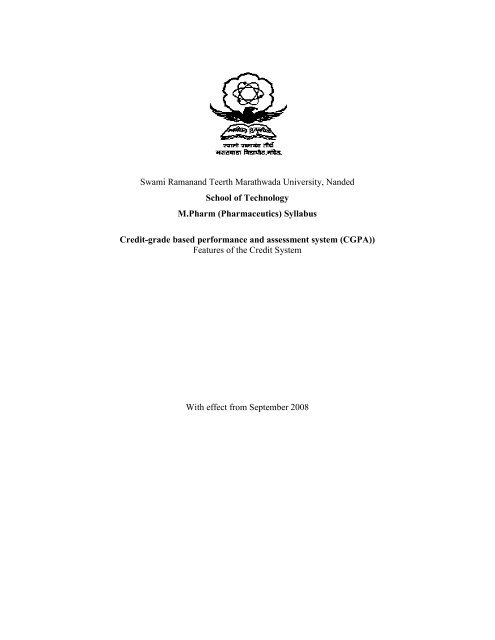
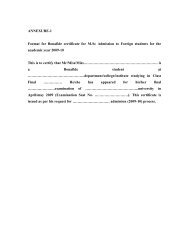
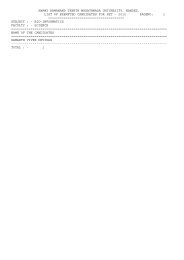
![Lokeh jkekuan rhFkZ ejkBokMk fo|kihB] ukan sM - - The Swami ...](https://img.yumpu.com/26553812/1/190x245/lokeh-jkekuan-rhfkz-ejkbokmk-fo-kihb-ukan-sm-the-swami-.jpg?quality=85)
